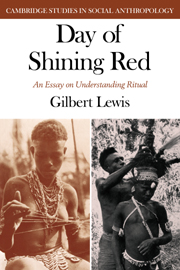Book contents
- Frontmatter
- Contents
- Analytical table of contents
- Preface
- 1 A question of interpretation
- 2 Problems of ritual in general
- 3 Views from one village
- 4 The rites of puberty seen
- 5 Rules of procedure and reflection on them
- 6 Silent forms but natural symbols?
- 7 Moon, river and other themes compared
- 8 For success in life
- 9 A choice of magic
- 10 Change and a rite falling into disuse
- 11 Inventory of themes
- References
- Index
- CAMBRIDGE STUDIES IN SOCIAL ANTHROPOLOGY
2 - Problems of ritual in general
Published online by Cambridge University Press: 30 October 2009
- Frontmatter
- Contents
- Analytical table of contents
- Preface
- 1 A question of interpretation
- 2 Problems of ritual in general
- 3 Views from one village
- 4 The rites of puberty seen
- 5 Rules of procedure and reflection on them
- 6 Silent forms but natural symbols?
- 7 Moon, river and other themes compared
- 8 For success in life
- 9 A choice of magic
- 10 Change and a rite falling into disuse
- 11 Inventory of themes
- References
- Index
- CAMBRIDGE STUDIES IN SOCIAL ANTHROPOLOGY
Summary
To begin with
Let me begin by summarising how I shall develop the argument of this chapter. I shall seek to relate the problems of defining ritual to problems of understanding the symbols and expressions of other people. Part of the argument is on questions of interpretation in which the anthropologist may think it right to go beyond what his informants tell him.
The attempt to set ritual apart from other kinds of activity and define a clear boundary round it has not gained general support. I put first the reasons why no adequate case can be made for separating ritual sharply as a special kind of action distinct from others. To avoid these objections, others have put forward the view that ritual is an aspect of many actions, not a kind of behaviour. The ritual aspect of behaviour is its expressive, symbolical or communicative aspect. By this view, the identification of ritual comes to be inextricably bound to the ability to recognise expression, symbol and communication. In some cases, the people who perform these behaviours do not or cannot put into words what they express, symbolise or try to communicate by them. Then if the anthropologist makes an interpretation, he is the only one who has been able to put that interpretation into words. If he had not done so, then perhaps neither he nor we nor the people who performed it should have distinguished that aspect of the action.
- Type
- Chapter
- Information
- Day of Shining Red , pp. 6 - 38Publisher: Cambridge University PressPrint publication year: 1980

